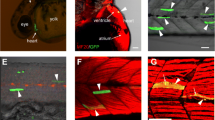Abstract.
Members of the myogenic regulatory gene family, including MyoD, Myf5, Myogenin and MRF4, are specifically expressed in myoblast and skeletal muscle cells and play important roles in regulating skeletal muscle development and growth. They are capable of converting a variety of non-muscle cells into myoblasts and myotubes. To better understand their roles in the development of fish muscles, we have isolated the MyoD genomic genes from gilthead seabream (Sparus aurata), analyzed the genomic structures, patterns of expression and the regulation of muscle-specific expression. We have demonstrated that seabream contain two distinct non-allelic MyoD genes, MyoD1 and MyoD2. Sequence analysis revealed that these two MyoD genes shared a similar gene structure. Expression studies demonstrated that they exhibited overlap** but distinct patterns of expression in seabream embryos and adult slow and fast muscles. MyoD1 was expressed in adaxial cells that give rise to slow muscles, and lateral somitic cells that give rise to fast muscles. Similarly, MyoD2 was initially expressed in both slow and fast muscle precursors. However, MyoD2 expression gradually disappeared in the adaxial cells of 10- to 15-somite-stage embryos, whereas its expression in fast muscle precursor cells was maintained. In adult skeletal muscles, MyoD1 was expressed in both slow and fast muscles, whereas MyoD2 was specifically expressed in fast muscles. Treating seabream embryos with forskolin, a protein kinase A activator, inhibited MyoD1 expression in adaxial cells, while expression in fast muscle precursors was not affected. Promoter analysis demonstrated that both MyoD1 and MyoD2 promoters could drive green fluorescence protein expression in muscle cells of zebrafish embryos. Together, these data suggest that the two non-allelic MyoD genes are functional in seabream and their expression is regulated differently in fast and slow muscles. Hedgehog signaling is required for induction of MyoD expression in adaxial cells.
Similar content being viewed by others
Author information
Authors and Affiliations
Additional information
Electronic Publication
Rights and permissions
About this article
Cite this article
Tan, X., Du, S. Differential expression of two MyoD genes in fast and slow muscles of gilthead seabream (Sparus aurata). Dev Genes Evol 212, 207–217 (2002). https://doi.org/10.1007/s00427-002-0224-5
Received:
Accepted:
Issue Date:
DOI: https://doi.org/10.1007/s00427-002-0224-5




